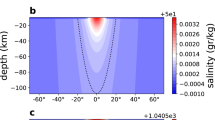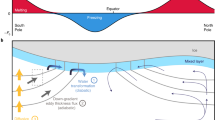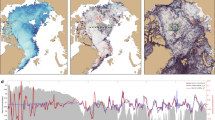Abstract
The ice shell of Jupiter’s moon Europa is marked by regions of disrupted ice known as chaos terrains that cover up to 40% of the satellite’s surface, most commonly occurring within 40° of the equator1. Concurrence with salt deposits2 implies a coupling between the geologically active ice shell and the underlying liquid water ocean at lower latitudes. Europa’s ocean dynamics have been assumed to adopt a two-dimensional pattern3,4,5,6,7,8, which channels the moon’s internal heat to higher latitudes. Here we present a numerical model of thermal convection in a thin, rotating spherical shell where small-scale convection instead adopts a three-dimensional structure and is more vigorous at lower latitudes. Global-scale currents are organized into three zonal jets and two equatorial Hadley-like circulation cells. We find that these convective motions transmit Europa’s internal heat towards the surface most effectively in equatorial regions, where they can directly influence the thermo-compositional state and structure of the ice shell. We suggest that such heterogeneous heating promotes the formation of chaos features through increased melting of the ice shell and subsequent deposition of marine ice at low latitudes. We conclude that Europa’s ocean dynamics can modulate the exchange of heat and materials between the surface and interior and explain the observed distribution of chaos terrains.
This is a preview of subscription content, access via your institution
Access options
Subscribe to this journal
Receive 12 print issues and online access
$259.00 per year
only $21.58 per issue
Buy this article
- Purchase on Springer Link
- Instant access to full article PDF
Prices may be subject to local taxes which are calculated during checkout




Similar content being viewed by others
References
Figueredo, P. H. & Greeley, R. Resurfacing history of Europa from pole-to-pole geological mapping. Icarus 167, 287–312 (2004).
Brown, M. E. & Hand, K. P. Salts and radiation products on the surface of Europa. Astron. J. 145, 110–110 (2013).
Thomson, R. E. & Delaney, J. R. Evidence for a weakly stratified Europan ocean sustained by seafloor heat flux. J. Geophys. Res. 106, 12355–12365 (2001).
Melosh, H. J., Ekholm, A. G., Showman, A. P. & Lorenz, R. D. The temperature of Europa’s subsurface water ocean. Icarus 168, 498–502 (2004).
Goodman, J. C., Collins, G. C., Marshall, J. & Pierrehumbert, R. T. Hydrothermal plume dynamics on Europa: Implications for chaos formation. J. Geophys. Res. 109, E03008 (2004).
Vance, S. & Brown, J. M. Layering and double-diffusion style convection in Europa’s ocean. Icarus 177, 506–514 (2005).
Vance, S. & Goodman, J. C. in Europa (eds Pappalardo, R. T., McKinnon, W. M. & Khurana, K. K.) 459–482 (Univ. Arizona Press, 2009).
Goodman, J. C. & Lenferink, E. Numerical simulations of marine hydrothermal plumes for Europa and other icy worlds. Icarus 221, 970–983 (2012).
Kivelson, M. G. et al. Galileo magnetometer measurements: A stronger case for a subsurface ocean at Europa. Science 289, 1340–1343 (2000).
Collins, G. & Nimmo, F. in Europa (eds Pappalardo, R. T., McKinnon, W. M. & Khurana, K. K.) 259–281 (Univ. Arizona Press, 2009).
Greenberg, R., Hoppa, G. V., Tufts, B. R., Geissler, P. & Riley, J. Chaos on Europa. Icarus 141, 263–286 (1999).
McKinnon, W. B. Convective instability in Europa’s floating ice shell. Geophys. Res. Lett. 26, 951–954 (1999).
Pappalardo, R. T. & Barr, A. C. The origin of domes on Europa: The role of thermally induced compositional diapirism. Geophys. Res. Lett. 31, L01701 (2004).
Schmidt, B. E., Blankenship, D. D., Patterson, G. W. & Schenk, P. M. Active formation of chaos terrain over shallow subsurface water on Europa. Nature 479, 502–505 (2011).
Hussmann, H., Spohn, T. & Wieczerkowski, K. Thermal equilibrium states of Europa’s ice shell: Implications for internal ocean thickness and surface heat flow. Icarus 156, 143–151 (2002).
Beuthe, M. Spatial patterns of tidal heating. Icarus 223, 308–329 (2013).
Heimpel, M. H. & Aurnou, J. M. Turbulent convection in rapidly rotating spherical shells: A model for equatorial and high latitude jets on Jupiter and Saturn. Icarus 187, 540–557 (2007).
Aurnou, J. M., Heimpel, M. H., Allen, L., King, E. M. & Wicht, J. Convective heat transfer and the pattern of thermal emission on the gas giants. Geophys. J. Int. 173, 793–801 (2008).
Julien, K., Knobloch, E., Rubio, A. M. & Vasil, G. M. Heat transport in low-Rossby-number Rayleigh–Bénard convection. Phys. Rev. Lett. 109, 254503 (2012).
King, E. M., Stellmach, S. & Aurnou, J. M. Heat transfer by rapidly rotating Rayleigh–Bénard convection. J. Fluid Mech. 691, 568–582 (2012).
Aurnou, J. M., Heimpel, M. H. & Wicht, J. The effects of vigorous mixing in a convective model of zonal flow on the Ice Giants. Icarus 190, 110–126 (2007).
Soderlund, K. M., Heimpel, M. H., King, E. M. & Aurnou, J. M. Turbulent models of ice giant internal dynamics: Dynamos, heat transfer, and zonal flows. Icarus 224, 97–113 (2013).
Lewis, E. L. & Perkin, R. G. Ice pumps and their rates. J. Geophys. Res. 91, 11756–11762 (1986).
Moore, J. C., Reid, A. P. & Kipfstuhl, J. Microphysical and electrical properties of marine ice and its relationship to meteoric and sea ice. J. Geophys. Res. 99, 5171–5180 (1994).
Oerter, H. et al. Evidence for basal marine ice in the Filchner–Ronne ice shelf. Nature 358, 399–401 (1992).
Ojakangas, G. W. & Stevenson, D. J. Polar wander of an ice shell on Europa. Icarus 81, 242–270 (1989).
Tyler, R. H. Magnetic remote sensing of Europa’s ocean tides. Icarus 211, 906–908 (2011).
Christensen, U. R. & Wicht, J. in Treatise on Geophysics, Core Dynamics Vol. 8 (ed. Schubert, G.) 245–282 (Elsevier, 2007).
Vance, S. & Brown, J. M. Thermodynamic properties of aqueous MgSO4 to 800 MPa at temperatures from −20 to 100 °C and concentrations to 2.5 mol kg−1 from sound speeds, with applications to icy world oceans. Geochim. Cosmochim. Acta 110, 176–189 (2013).
Kuang, W. & Bloxham, J. An earth-like numerical dynamo model. Nature 389, 371–374 (1997).
Acknowledgements
This work was supported by the Institute for Geophysics of the Jackson School of Geosciences at The University of Texas at Austin (UTIG). Computational resources were provided by the NASA High-End Computing (HEC) Program through the NASA Advanced Supercomputing (NAS) Division at Ames Research Center. We thank M. Heimpel for providing the jovian-like model data in Fig. 1, T. Doggett for providing the geologic map of Europa in Supplementary Fig. 1, and J. Aurnou for providing Supplementary Fig. 2. This is UTIG contribution 2637.
Author information
Authors and Affiliations
Contributions
K.M.S. and B.E.S. conceived of this project and wrote the paper. K.M.S. did all calculations and carried out the simulation. J.W. provided the numerical model and contributed to the convective regime transition arguments. D.D.B. contributed to the terrestrial analogue arguments. All authors discussed the results and commented on the manuscript.
Corresponding author
Ethics declarations
Competing interests
The authors declare no competing financial interests.
Supplementary information
Supplementary Information
Supplementary Information (PDF 988 kb)
Supplementary movie 1
Supplementary movie 1 (MOV 5272 kb)
Rights and permissions
About this article
Cite this article
Soderlund, K., Schmidt, B., Wicht, J. et al. Ocean-driven heating of Europa’s icy shell at low latitudes. Nature Geosci 7, 16–19 (2014). https://doi.org/10.1038/ngeo2021
Received:
Accepted:
Published:
Issue Date:
DOI: https://doi.org/10.1038/ngeo2021
This article is cited by
-
Particle entrainment and rotating convection in Enceladus’ ocean
Communications Earth & Environment (2023)
-
Investigating Europa’s Habitability with the Europa Clipper
Space Science Reviews (2023)
-
Exploring the Interior of Europa with the Europa Clipper
Space Science Reviews (2023)
-
Dynamic Europa ocean shows transient Taylor columns and convection driven by ice melting and salinity
Nature Communications (2021)
-
A pole-to-equator ocean overturning circulation on Enceladus
Nature Geoscience (2021)



